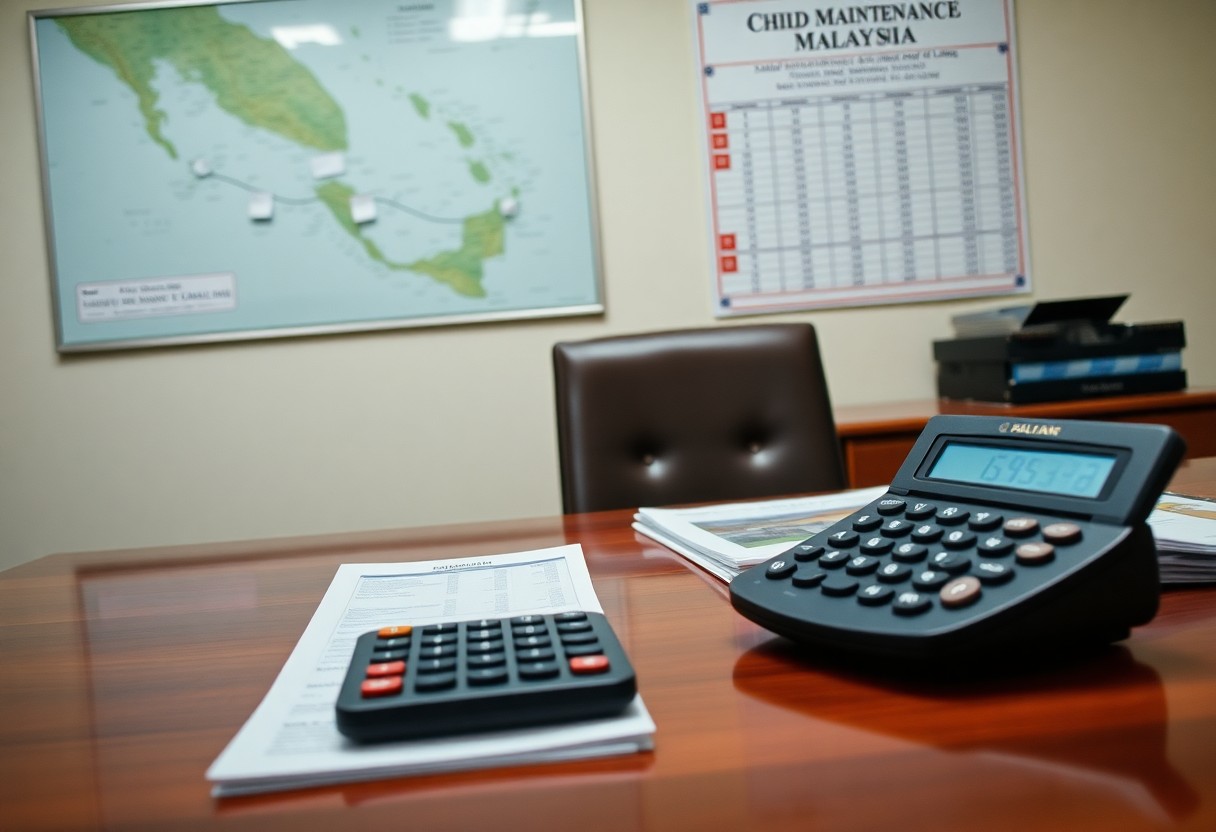It’s important for you to understand how maintenance for children is calculated in Malaysia, particularly if you’re navigating the complexities of divorce or separation. The calculation takes into account various factors such as your child’s needs, your income, and the standard of living your child is accustomed to. Understanding these elements helps ensure that you provide adequate support. Ignoring these responsibilities can lead to serious legal consequences and affect your child’s well-being.
Key Takeaways:
- Maintenance amounts are determined based on the needs of the child and the financial ability of the parents.
- The Malaysian legal framework considers factors such as the child’s standard of living prior to separation.
- Both parents’ income and expenses are assessed to ensure equitable contribution to child support.
- Courts may consider the age and health of the child when setting maintenance amounts.
- Adjustments to maintenance can be requested due to changes in circumstances or financial status.
- Parents have a responsibility to provide for educational and healthcare needs in addition to basic living expenses.
- Mediation is encouraged to resolve maintenance disputes before court intervention is necessary.
The Legal Framework Defining Child Maintenance in Malaysia
In Malaysia, child maintenance is governed by a blend of statutory provisions and personal laws, reflecting the country’s diverse legal landscape. The key legislations include the Law Reform (Marriage and Divorce) Act 1976 and specific Islamic laws applicable to Muslim families, which outline the obligations of parents to provide financial support for their children. Additionally, these laws emphasize the child’s welfare as a priority, ensuring that maintenance decisions focus on their best interests.
Key Legislations and Guidelines
The primary legislation regarding child maintenance in Malaysia is the Law Reform (Marriage and Divorce) Act 1976 for non-Muslims, while Muslim families follow the Syariah law. Both frameworks articulate the necessity for parental support, detailing how maintenance amounts can be determined based on the child’s needs, living standards, and the parents’ financial capabilities. Guidelines under these laws provide benchmarks to assist courts in making fair decisions.
Role of Family Courts in Maintenance Calculation
Family Courts play an important role in determining and enforcing child maintenance agreements. They assess financial documents, consider the incomes and obligations of both parents, and evaluate the child’s specific needs. Through hearings, judges can facilitate negotiations between parents, aiming for mutually agreeable terms that prioritize the child’s welfare.
Further involvement of Family Courts includes using structured formulas for maintenance calculation, ensuring consistency in decisions. They factor in elements such as educational expenses, healthcare needs, and general living costs while accounting for both parents’ ability to pay. In cases of non-compliance, courts are empowered to enforce payments, protecting the child’s rights effectively. This mechanism reinforces the commitment to uphold the child’s financial security during and after parental separation.

Factors Influencing Child Maintenance Amounts
Several factors influence the determination of child maintenance amounts in Malaysia. These include the income levels of the parents, the child’s needs, and the standard of living the child was accustomed to before any separation. Additional aspects such as the number of children involved and the cost of living in different regions also play a significant role. The overall financial landscape shapes the expectations and requirements for appropriate maintenance payments.
Income Considerations for Parents
Your income is a major component when calculating child maintenance. Courts typically examine the gross monthly wages of both parents, any other sources of income, and overall financial stability. For instance, if you earn RM10,000 monthly while your former partner has a significantly lower income, this disparity will heavily influence the maintenance assessments. The primary goal is to ensure that the child’s needs are met without placing undue financial burden on either parent.
Additional Expenses and Child Needs
Assessing additional expenses is vital in understanding the full scope of what a child requires. This encompasses not only daily living costs like food, clothing, and housing but also educational expenses, medical needs, and extracurricular activities. For instance, if your child has specific educational needs, such as attending a special school or requiring tutoring, these costs must be incorporated into the maintenance calculation. The overall expense profile directly impacts the maintenance amount you might be expected to contribute.
Expenses related to your child’s healthcare, such as regular check-ups or medications, should also be accounted for in the maintenance assessment. Educational costs, including tuition fees, school supplies, and transport, reflect another significant area of need. If additional activities, such as sports or arts, play a role in your child’s development, including those expenses further emphasizes their overall needs. The goal remains to ensure a comprehensive understanding of all financial obligations tied to the child’s well-being.

Calculating Maintenance: The Methodology
Various methodologies are employed to calculate child maintenance in Malaysia, taking into account both *financial needs* and *parental capabilities*. Courts typically analyze your income, living expenses, and the child’s *standard of living* before the separation. A common approach is to consider necessary expenses, such as *education, healthcare, and daily needs*, while ensuring the amount remains equitable and does not impose undue financial strain on either parent.
Standard Calculation Formulas in Practice
Commonly, maintenance amounts are derived using basic formulas that factor in the *monthly income of both parents* and the number of children involved. For instance, a *percentage-based system* might allocate a specific percentage of your income to the upkeep of each child, ensuring that contributions reflect both your financial situation and the living costs necessary to support their well-being.
Variations Based on Custody Arrangements
Custody arrangements significantly influence maintenance calculations, as they determine your role in day-to-day child care. In shared custody situations, you may find the maintenance amount adjusted to account for the split in responsibilities and expenses. Factors like your *housing situation* and the *frequency of visitation* can also play a role in establishing a fair amount.
Variations in maintenance calculations stem from whether you have *sole, joint, or shared custody*. For example, with sole custody, maintenance might lean heavily towards your financial support due to exclusive care duties. Conversely, in joint custody scenarios, costs may be evenly distributed, recognizing that both parents contribute to *child-rearing* at different times, thus minimizing the maintenance burden on one party alone. Additionally, *shared living arrangements* where the child spends equal time with both parents could lead to adjusted maintenance expectations that align with practical caregiving responsibilities.

Common Misconceptions Surrounding Child Maintenance
Despite the legal framework governing child maintenance in Malaysia, several misconceptions persist that can impact your understanding and obligations. Many believe that maintenance calculations are arbitrary or solely based on the custodial parent’s income. In reality, calculations rely on a range of factors, including both parents’ financial situations, the child’s needs, and applicable guidelines. These misunderstandings can lead to disputes and challenges in meeting lawful obligations.
Myths Related to Income and Obligations
One prevalent myth is that child maintenance is only determined by the custodial parent’s income. The truth is that courts consider both parents’ earnings, including bonuses, assets, and liabilities, when calculating what is deemed fair for child support. This comprehensive perspective helps ensure that the child’s best interests are met while holding both parents accountable.
Clarifying Parental Rights and Responsibilities
Many parents believe that paying maintenance absolves them of further parental responsibilities. In fact, financial support is just one aspect of your obligations. You must also ensure active participation in your child’s life, including emotional support and involvement in their education and well-being. Understanding your rights as a non-custodial parent is equally vital, including the right to visitation and co-parenting decisions, which contribute to a balanced upbringing for your child.
Clarifying parental rights and responsibilities entails recognizing that financial obligations do not replace your role in fostering a nurturing environment. Both parents are entitled to remain significant figures in the child’s life, regardless of living arrangements. Good communication and cooperation between parents can ease tensions and promote a more positive experience for the child, ensuring shared responsibilities are met while allowing for a loving and supportive relationship.
Future Trends in Child Maintenance Calculations
Emerging trends in child maintenance calculations in Malaysia reflect a shift towards more personalized assessments. As the cost of living continues to rise, methodologies may increasingly factor in individual circumstances, such as unique financial situations and shifting market dynamics. Technology will likely play a significant role, enhancing data collection and analysis to improve the accuracy and fairness of maintenance calculations. These trends suggest a greater focus on adaptability, with courts possibly adopting more flexible approaches to meet the evolving needs of families.
Impact of Economic Changes on Maintenance Assessments
Economic fluctuations significantly influence maintenance assessments. As inflation rises and employment rates change, your child’s maintenance needs may be reassessed to ensure adequate support. For instance, periods of economic downturn necessitate adjustments in maintenance amounts based on decreased income levels or increased living costs, reflective of the important relationship between economic health and child support obligations.
Legal Reforms and Potential Implications
Ongoing legal reforms in Malaysia are shaping the future of child maintenance assessments. These reforms typically aim to standardize calculations and ensure that all parties are treated equitably. As seen with recent amendments to family law, more emphasis on shared parenting arrangements and joint financial responsibilities may impact how maintenance amounts are determined, creating a more balanced approach that better reflects contemporary family dynamics.
The legal reforms focus on implementing guidelines that address transparency in income disclosure and facilitate smoother modifications to maintenance agreements. For example, proposed frameworks may establish clear criteria for recalculating maintenance regularly, considering factors like surges in a parent’s income or changes in the child’s needs. As these reforms progress, they can promote greater fairness and consistency in child maintenance calculations, ultimately benefiting both parents and children.
Conclusion
Summing up, maintenance for children in Malaysia is calculated based on several factors, including your income, the child’s needs, and the living standards previously established. You should consider the age and health of the child, any special educational requirements, and additional expenses like medical care. It’s vital to ensure that your calculations reflect the child’s best interests while remaining fair to both parents. Understanding these elements will help you navigate the process more effectively and ensure adequate support for your child.
FAQ
Q: What factors are considered in calculating child maintenance in Malaysia?
A: Factors include the income of both parents, the living expenses of the child, educational needs, and any special requirements of the child.
Q: How is the income of both parents assessed?
A: The income is typically assessed based on the most recent payslips, tax returns, or other financial documents provided by both parents.
Q: Is there a fixed percentage used to determine child maintenance?
A: There is no fixed percentage; however, courts may refer to guidelines that suggest a certain range based on the parent’s income and the number of children.
Q: Can child maintenance orders be modified?
A: Yes, maintenance orders can be modified if there is a significant change in circumstances such as job loss or a change in the child’s needs.
Q: How can a parent enforce child maintenance payments?
A: A parent can enforce payments through legal channels, which may include seeking a court order or involving the Department of Social Welfare.
Q: What happens if a parent refuses to pay child maintenance?
A: Legal action can be taken against the non-paying parent, including wage garnishment or other enforcement measures as determined by the court.
Q: Are there any tax implications associated with child maintenance in Malaysia?
A: Child maintenance payments are generally not tax-deductible, and receiving parents do not pay taxes on these amounts as income.
